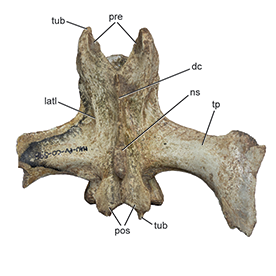A NON-FURILEUSAURIAN CAUDAL VERTEBRA FROM BAJO DE LA CARPA FORMATION (SANTONIAN) AND MORPHOLOGICAL VARIATION IN THE TAIL OF ABELISAURIDAE
DOI:
https://doi.org/10.5710/PEAPA.15.10.2022.438Keywords:
Abelisauridae, Caudal vertebra, Upper Cretaceous, Patagonia, Cerro Overo-La Invernada fossil areaAbstract
The Cerro Overo-La Invernada area in north Patagonia has provided a rich record of Cretaceous continental tetrapods in the last two decades, mainly from the Bajo de la Carpa Formation (Upper Cretaceous, Santonian). The dinosaur fauna from this area is diverse, including several new taxa, with abelisaurid theropods particularly abundant. Recently, a new isolated caudal vertebra (MAU-Pv-CO-598) was here recovered. Although fragmentary, it shows features that differentiate it from other abelisaurid remains previously found in this area. It is considered a mid-caudal vertebra and is mainly characterized by a longitudinal groove on the ventral surface of the centrum; a scarcely elevated transverse process with an anteroposteriorly expanded and laterally concave distal end; a longitudinal dorsal crest anteriorly extended from the anterior border of the neural spine; and small tubercles extended from the ends of the zygapophyses, which are considered as accessory interlocking structures between vertebrae. Some characters, such as the dorsal longitudinal crest and the accessory tubercles of the zygapophyses, are present also in the non-brachyrostran abelisaurid Majungasaurus. However, the transverse process is similar to that of caudal vertebrae of non-furileusaur brachyrostrans, such as Ilokelesia, Ekrixinatosaurus, and Skorpiovenator. A phylogenetic analysis here conducted clusters MAU-Pv-Co-598 with the latter three taxa. MAU-Pv-CO-598 comes from lower levels of the Bajo de la Carpa Formation than the furileusaurs Viavenator and Llukalkan. The presence of a specimen with non-furileusaurian affinities in this formation indicates that a possible replacement from non-furileusaur to furileusaur brachyrostrans occurred during the Santonian, after the proposed Turonian faunal turnover.
References
Allain, R., & Pereda-Suberbiola, X. (2003). Dinosaurs of France. Comptes Rendus Palevol, 2(1), 27–44.
Aranciaga-Rolando, M. A., Cerroni, M. A., Garcia Marsá, J. A., Agnolín, F. L., Motta, M. J., Rozadilla, S., Brisson Eglí, F., & Novas, F. E. (2021). A new medium-sized abelisaurid (Theropoda, Dinosauria) from the late cretaceous (Maastrichtian) Allen Formation of Northern Patagonia, Argentina. Journal of South American Earth Sciences, 105, 102915. https://doi.org/10.1016/j.jsames.2020.102915.
Baiano, M. A., Coria, R. A., Canale, J. I., & Gianechini, F. A. (2021). New abelisaurid material from the Anacleto Formation (Campanian, Upper Cretaceous) of Patagonia, Argentina, shed light on the diagnosis of the Abelisauridae (Theropoda, Ceratosauria). Journal of South American Earth Sciences, 110, 103402. https://www.sciencedirect.com/science/article/pii/S0895981121002492?via%3Dihub
Barker, C. T., Hone, D. W. E., Naish, D., Cau, A., Lockwood, J. A. F., Foster, B., Clarkin, C. E., Schneider, P., & Gostling, N. J. (2021). New spinosaurids from the Wessex Formation (Early Cretaceous, UK) and the European origins of Spinosauridae. Scientific Reports, 11, 19340. https://doi.org/10.1038/s41598-021-97870-8
Bonaparte, J. F. (1985). A horned Cretaceous carnosaur from Patagonia. National Geographic Research, 1, 149–151.
Bonaparte, J. F. (1991). Los vertebrados fósiles de la Formación Río Colorado, de la ciudad de Neuquén y cercanías, Cretácico superior, Argentina. Revista del Museo Argentino de Ciencias Naturales: Paleontología, 4(3), 17–123.
Bonaparte, J. F., & Novas, F. E. (1985). Abelisaurus comahuensis, n. g., n. sp., Carnosauria del Cretácico Tardío de Patagonia. Ameghiniana, 21(2-4), 259–265.
Bonaparte, J. F., Novas, F. E., & Coria, R. A. (1990). Carnotaurus sastrei Bonaparte, the horned, lightly built carnosaur from the Middle Cretaceous of Patagonia. Contributions in Science, Natural History Museum of Los Angeles County, 416, 1-42.
Bremer, K. (1988). The limits of amino acid sequence data in angiosperm phylogenetic reconstruction. Evolution, 42(4), 795–803.
Bremer, K. (1994). Branch support and tree stability. Cladistics, 10(3), 295–304.
Buffetaut, E., Mechin, P., & Mechin-Salessy, A. (1988). Un dinosaure théropoded’affinités gondwaniennes dans le Crétacé supérieur de Provence. Comptes Rendus de l'Académie de Sciences de Paris Serie II A, 306, 153–158.
Calvo, J. O., Rubilar-Roger, D., & Moreno, K. (2004). A new Abelisauridae (Dinosauria: Theropoda) from northwest Patagonia. Ameghiniana, 41(4), 555–563.
Canale, J. I., Novas, F. E., & Pol, D. (2015). Osteology and phylogenetic relationships of Tyrannotitan chubutensis Novas, de Valais, Vickers-Rich and Rich, 2005 (Theropoda: Carcharodontosauridae) from the Lower Cretaceous of Patagonia, Argentina. Historical Biology, 27(1), 1–32.
Canale, J. I., Scanferla, C. A., Agnolín, F. L., & Novas, F. E. (2009). New carnivorous dinosaur from the Late Cretaceous of NW Patagonia and the evolution of abelisaurid theropods. Naturwissenschaften, 96(3), 409–414.
Carrano, M. T., Sampson, S. D., & Forster, C. A. (2002). The osteology of Masiakasaurus knopfleri, a small abelisauroid (Dinosauria: Theropoda) from the Late Cretaceous of Madagascar. Journal of Vertebrate Paleontology, 22(3), 510–534.
Cerroni, M. A., & Paulina-Carabajal, A. (2019). Novel information on the endocranial morphology of the abelisaurid theropod Carnotaurus sastrei. Comptes Rendus Palevol, 18, 985–995.
Coria, R. A., Chiappe, L. M., & Dingus, L. (2002). A new close relative of Carnotaurus sastrei Bonaparte 1985 (Theropoda: Abelisauridae) from the Late Cretaceous of Patagonia. Journal of Vertebrate Paleontology, 22(2), 460–465.
Coria, R. A., & Currie, P. J. (2006). A new carcharodontosaurid (Dinosauria, Theropoda) from the Upper Cretaceous of Argentina. Geodiversitas, 28(1), 71–118.
Coria, R. A., Currie, P., & Paulina-Carabajal, A. (2006). A new abelisaurid theropod from northwestern Patagonia. Canadian Journal of Earth Sciences, 43, 1283–1289.
Coria, R. A., & Salgado, L. (1998). A basal Abelisauria Novas, 1992 (Theropoda-Ceratosauria) from the Cretaceous of Patagonia, Argentina. Gaia, 15, 89–102.
Coria, R. A., & Salgado, L. (2005). Mid-Cretaceous turnover of saurischian dinosaur communities: evidence from the Neuquén Basin. In G. D. Veiga, L. A. Spalletti, J. A. Howell, & E. Schwarz (Eds.), The Neuquén Basin, Argentina: A Case Study in Sequence Stratigraphy and Basin Dynamics (pp. 317–327). Geological Society of London Special Publications, London.
Currie, P. J., & Carpenter, K. (2000). A new specimen of Acrocanthosaurus atokensis (Theropoda, Dinosauria) from the Lower Cretaceous Antlers Formation (Lower Cretaceous, Aptian) of Oklahoma, USA. Geodiversitas, 22(2), 207–246.
Currie, P. J., & Chen, P. -J. (2001). Anatomy of Sinosauropteryx prima from Liaoning, northeastern China. Canadian Journal of Earth Sciences, 38, 1705–1727.
Ezcurra, M. D., & Méndez, A. H. (2009). First report of a derived abelisaurid theropod from the Bajo de la Carpa Formation (Late Cretaceous), Patagonia, Argentina. Bulletin of Geosciences, 84(3), 547–554.
Farke, A. A., & Sertich, J. J. W. (2013). An abelisauroid theropod dinosaur from the Turonian of Madagascar. PLoS One, 8(4), e62047. https://journals.plos.org/plosone/article?id=10.1371/journal.pone.0062047
Filippi, L. S., Méndez, A. H., Gianechini, F. A., Juárez-Valieri, R. D., & Garrido, A. C. (2018). Osteology of Viavenator exxoni (Abelisauridae; Furileusauria) from the Bajo de la Carpa Formation, NW Patagonia, Argentina. Cretaceous Research, 83, 95–119.
Filippi, L. S., Méndez, A. H., Juárez Valieri, R. D., & Garrido, A. C. (2016). A new brachyrostran with hypertrophied axial structures reveals an unexpected radiation of latest Cretaceous abelisaurids. Cretaceous Research, 61, 209–219.
Gianechini, F. A., Apesteguía, S., Landini, W., Finotti, F., Juarez-Valieri, R. D., & Zandonai, F. (2015). New abelisaurid remains from the Anacleto Formation (Upper Cretaceous), Patagonia, Argentina. Cretaceous Research, 54, 1–16.
Gianechini, F. A., Méndez, A. H., Filippi, L. S., Paulina-Carabajal, A., Juárez-Valieri, R. D., & Garrido, A. C. (2021). A new furileusaurian abelisaurid from La Invernada (Upper Cretaceous, Santonian, Bajo de la Carpa Formation), northern Patagonia, Argentina, Journal of Vertebrate Paleontology, 40(6): e1877151. https://www.tandfonline.com/doi/abs/10.1080/02724634.2020.1877151?journalCode=ujvp20
Goloboff, P. A., & Catalano, S. A. (2016). TNT version 1.5, including a full implementation of phylogenetic morphometrics. Cladistics, 32(3), 221–238.
Harris, J. D. (1998). A reanalysis of Acrocanthosaurus atokensis, its phylogenetic status, and paleobiogeographic implications, based on a new specimen from Texas. New Mexico Museum of Natural History and Science Bulletin, 13, 1–75.
Huene, F. von, & Matley, A. (1933). The Cretaceous Saurischia and Ornithischia of the central provinces of India. Palaeontologica Indica (New Series), Memoirs of the Geological Survey of India, 21(1), 1–74.
Juárez Valieri, R. D., Calvo, J. O., & Ríos Díaz, S. D. (2011). Sauropods crossing formations: biostratigraphical implications for patagonian faunal assemblages. In J. O. Calvo, J. D. Porfiri, B. J. González Riga, & D. D. Dos Santos (Eds.), Paleontología y Dinosaurios desde América Latina (pp. 153–160). Editorial de la Universidad Nacional de Cuyo, Mendoza, Argentina.
Lamanna, M. C., Casal, G. A., & Martínez, R. D. (2012). A new abelisaurid (Theropoda: Ceratosauria) skeleton from the Upper Cretaceous Bajo Barreal Formation of Chubut Province, Argentina. Journal of Vertebrate Paleontology, Program and Abstracts: 124.
Lamanna, M. C., Martínez, R. D., Luna, M., Casal, G. A., Dodson, P. D., & Smith, J. B. (2001). Sauropod faunal transition through the Cretaceous Chubut Group of central Patagonia. Journal of Vertebrate Paleontology, 21(3, Supplement), 70A.
Le Loeuff, J., & Buffetaut, E. (1991). Tarascosaurus salluvicus nov. gen., nov. sp., dinosaure théropode du Crétacé supérieur du Sud de la France. Geobios, 24(5), 585–594.
Madsen, J. H. (1976). Allosaurus fragilis: a revised osteology. Utah Geological and Mineral Survey, Bulletin, 109, 1–163.
Marsh, O. C. (1881). Principal characters of American Jurassic dinosaurs. Part V. The American Journal of Science and Arts, series 3, 21, 417–423.
Marsh, O. C. (1884). Principal characters of American Jurassic dinosaurs. Part VIII. The order Theropoda. American Journal of Science, 27, 329–340.
Méndez, A. H. (2014a). The caudal vertebral series in abelisaurid dinosaurs. Acta Palaeontologica Polonica, 59(1), 99–107.
Méndez, A. H. (2014b). The cervical vertebrae of the Late Cretaceous abelisaurid dinosaur Carnotaurus sastrei. Acta Palaeontologica Polonica, 59(3), 569–579.
Méndez, A. H., Filippi, L. S., Gianechini, F. A., & Juárez-Valieri, R. D. (2018). New brachyrostran remains (Theropoda, Abelisauridae) from La Invernada fossil site (Bajo de la Carpa Formation, Upper Cretaceous), northern Patagonia, Argentina. Cretaceous Research, 83, 120–126.
Méndez, A. H., Gianechini, F. A., Paulina-Carabajal, A., Filippi, L. S., Juárez-Valieri, R. D., Cerda, I. A., & Garrido, A. C. (2022). New furileusaurian remains from La Invernada (northern Patagonia, Argentina): A site of unusual abelisaurids abundance. Cretaceous Research, 129, 104989. https://www.sciencedirect.com/science/article/pii/S0195667121002378?via%3Dihub
Novas, F. E., Agnolín, F. L., Ezcurra, M. D., Porfiri, J., & Canale, J. I. (2013). Evolution of the carnivorous dinosaurs during the Cretaceous: the evidence from Patagonia. Cretaceous Research, 45, 174–215.
O’Connor, P. M. (2007). The postcranial axial skeleton of Majungasaurus crenatissimus (Theropoda: Abelisauridae) from the Late Cretaceous of Madagascar. Society of Vertebrate Paleontology, Memoir, 8, 127–162.
Rauhut, O. W. M. (2003). The interrelationships and evolution of basal theropod dinosaurs. Special Papers in Palaeontology, 69, 1–213.
Rauhut, O. W. M., & Carrano, M. (2016). The theropod dinosaur Elaphrosaurus bambergi Janensch, 1920, from the Late Jurassic of Tendaguru, Tanzania. Zoological Journal of the Linnean Society, 178(3), 546–610.
Samathi, A., Sander, P. M., & Chanthasit, P. (2021). A spinosaurid from Thailand (Sao Khua Formation, Early Cretaceous) and a reassessment of Camarillasaurus cirugedae from the Early Cretaceous of Spain. Historical Biology, 33(12), 3480–3494.
Sanchez-Hernández, B., & Benton, M. J. (2014). Filing the ceratosaur gap: a new ceratosaurian theropod from the Early Cretaceous of Spain. Acta Palaeontologica Polonica, 59(3), 581–600.
Sereno, P. C., Beck, A. L., Dutheil, D. B., Gado, B., Larsson, H. C., Lyon, G. H., Marcot, J. D, Rauhut, O. W., Sadleir, R. W., Sidor, C. A., Varricchio, D. D., Wilson, G. P., & Wilson, J. A. (1998). A long-snouted predatory dinosaur from Africa and the evolution of spinosaurids. Science, 282(5392), 1298–1302.
Tortosa, T., Buffetaut, E., Vialle, N., Dutour, Y., Turini, E., & Cheylan, G. (2014). A new abelisaurid dinosaur from the Late Cretaceous of southern France: palaeobiogeographical implications. Annales de Paléontologie, 100, 63–86.

Additional Files
Published
Issue
Section
License
Copyright (c) 2022 Federico Gianechini, Leonardo Filippi, Ariel Méndez, Alberto Garrido

This work is licensed under a Creative Commons Attribution-NoDerivatives 4.0 International License.
Authors retain copyright and grant the journal right of first publication with the work simultaneously licensed under a Atribución/Reconocimiento 4.0 Internacional that allows others to share the work with an acknowledgement of the work's authorship and initial publication in this journal.















